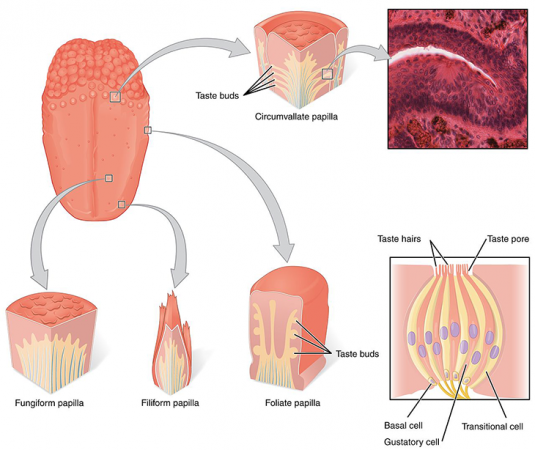A cell hookup helps the tongue tell sweet from sour
Bitter lemon or banana? Taste cells know how to summon the right brain cells to ‘read’ flavors correctly

How does a tongue taste banana? For the brain to taste a banana as sweet, the tongue and the brain need to communicate with the right cellular “handshake.”
KatarzynaBialasiewicz/istockphoto
When a flavor hits the tongue, it activates a taste cell — for sweet, salty, bitter, sour or umami (savory). That taste cell then passes the delicious message on to a brain cell so your brain knows whether the mouth is tasting cake or steak. When those taste cells die — and they do — new ones take their place. How do those new cells find the right brain connections without getting mixed up? They send a specific, irresistible chemical summons, a new study shows.
Your tongue is a constantly changing landscape. The surface is covered in taste buds, and each bud is filled with a mix of different types of taste-receptor cells. The base of each taste cell in the bud is linked to a long tail called an axon. That axon is part of a brain cell, or neuron, located in a bundle of cells just behind your ear. This cell bundle takes the information from each taste-receptor cell and passes it along. This allows our brains to taste the difference between apples and anchovies.
The cells in your taste buds make direct contact with everything that ends up in your mouth. Along the way, they may get burned or poked or bitten. So each cell only lives a short time. How short? Perhaps only about one to three weeks. As the cells die off, new ones emerge to take over for the old ones.
Those new cells have to hook up to the proper neurons. “You don’t want bitter-taste-receptor cells hooking up with a sweet neuron,” explains Hojoon Lee. He is a neuroscientist — someone who studies the brain — at Columbia University in New York City. New sweet-taste cells need to link to sweet neurons. Bitter ones must join up with bitter neurons. If, by accident, some bitter-taste-receptor cell did link up to a sweet neuron, Lee says, the animal or person might mistake bitter things — which often are poisonous — for a harmless sweet food. And that could be a potentially deadly mistake.
How do the new taste-receptor cells find the right neurons? “I thought there must be something those taste receptor cells had which ensured miswiring wouldn’t happen,” Lee says. To find out what it was, he and his colleagues removed taste-receptor cells for sweet and bitter from mice. Then they looked at what genes — or sets of instructions — those cells had been using to function.
Story continues below image.

Hacking cellular communication
The scientists hoped to find instructions for signaling particular neurons. And soon they hit upon a group of molecules called semaphorins (Seh-mah-FOR-ins). These chemicals are named for semaphores. These are systems in which people communicate by moving brightly colored flags. Those flags, and their messages, can be seen from far away. Semaphorin molecules aren’t flags. But cells use these chemicals to communicate with neurons, attracting some and repelling others.
Bitter-taste cells made a lot of one type of semaphorin, known as 3A. Sweet-taste cells made a lot of type 7A. To find out if each type summoned different neurons to the taste cells, Lee and his colleagues created something called a knockout mouse. This mouse had a special gene that would make bitter-taste cells delete semaphorin 3A if the mouse received a certain drug. After this happened, the researchers watched as the new cells tried to hook up with the correct neurons.
Without semaphorin 3A, bitter neurons seemed to have lost their roadmap. Nearly half inappropriately hooked up with salty-, sweet- or umami-taste cells. Oops.
“We saw that bitter neurons were making more mistakes and going elsewhere,” Lee says. “We took this to mean that 3A is the guiding signal that brings the bitter neurons to the bitter-taste-receptor cells.”
But they didn’t know that for sure. Semaphorin 3A could have been attracting the bitter neurons. Or they might instead have pushed away sweet, salty, sour and umami. That would have left bitter as the only receptors left to match up with them. To find out whether the semaphoring actually called out to bitter neurons, the scientists performed another experiment. They made the sweet- and umami-taste cells in other mice inappropriately produce semaphorin 3A. Now the bitter neurons came racing to hook up with sweet and umami cells.
When Lee and his colleagues did the same studies with semaphorin 7A, they got similar results. Sweet neurons responded to sour-taste cells that were making semaphorin 7A.
The scientists shared their findings August 9 in the journal Nature.
“Among the five senses, taste is probably the least known or examined,” says Yuki Oka. He studies the brain at the California Institute of Technology in Pasadena. He was not involved in the Lee’s study but finds it “very elegant.”
While the studies were all done in mice, there’s no reason to think human taste cells would be too different, Oka says. “It’s the same system,” he explains. Any molecule involved might be a little different, “but it’s likely to be similar.”
Lee and his colleagues so far have found semaphorin molecules only for sweet and bitter. They are testing others for sour, salty and umami cells. But there’s probably far more than just one molecule controlling the final hookup, Lee points out. Why does he say that? Even when the bitter or sweet taste cells had no semaphorins, the neurons still found their way to the proper taste receptor about half the time. This means that other molecules probably help the neurons find their way. After all, when it comes to tasting the difference between poisons and pie, you can never have too much insurance.







